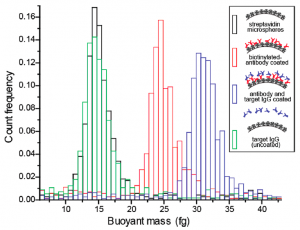Quantifying Particle Coatings Using High-precision Mass Measurements
- Category: MEMS & BioMEMS
- Tags: scott manalis

Figure 1: Streptavidin-functionalized polystyrene microspheres are coated with two layers of protein; the first via the streptavidin−biotin interaction and the second via antibody−antigen binding. Particle populations were measured in a solution just below the bulk density of the core microspheres and are plotted at an equivalent solution density. The protein layers add 9.8 and 6.5 fg of buoyant mass, respectively; equivalent to approximately 150 and 100 ng/cm2 absolute mass, assuming a protein density of 1.35 g/cm3.
Microparticles are currently used in a variety of industrial and biomedical applications and are often coated with different materials to impart functionality for applications such as drug delivery, cell extraction, and biomolecular detection. In many cases, the amount of coating affects the functionality of the particle. Label-based methods such as fluorescence are commonly used for biomolecular detection applications. However, labeling is not always practical and may not be an option in cases where a material layer is added. Although there is a wide range of label-free approaches for measuring the amount of coating on a flat surface, there are very few analogous approaches for particles.
We have previously demonstrated that the suspended microchannel resonator (SMR) can weigh individual microparticles with femtogram precision. Although this level of precision is sufficient to resolve meaningful differences in coating thicknesses between populations of microparticles, such measurements have remained challenging for two reasons: (i) since the weight of the microparticle is generally many orders of magnitude larger than its coating, variation in particle mass across even the most monodisperse population can obscure the mass of the coating and (ii) sample-to-sample variations in the density of the carrier solution and density drift during the measurement of an individual sample give rise to significant differences in buoyant mass. Here we address these limitations by adjusting the density of the carrier solution to diminish the buoyant mass of the particle with respect to its coating and by monitoring solution density throughout the measurement using rapid fluid exchanges with a reference solution in an adjacent bypass[1]. This method is appropriate for polymer-based microparticles coated with materials of a different density. For a protein coating on a 3-μm polystyrene microsphere, we can resolve approximately 10% of a full layer (Figure 1).
- S. M. Knudsen, M. G. von Muhlen and S. R. Manalis, “Quantifying particle coatings using high-precision mass measurements,” Analytical Chemistry, vol. 84, pp. 1240-1242, 2012. [↩]